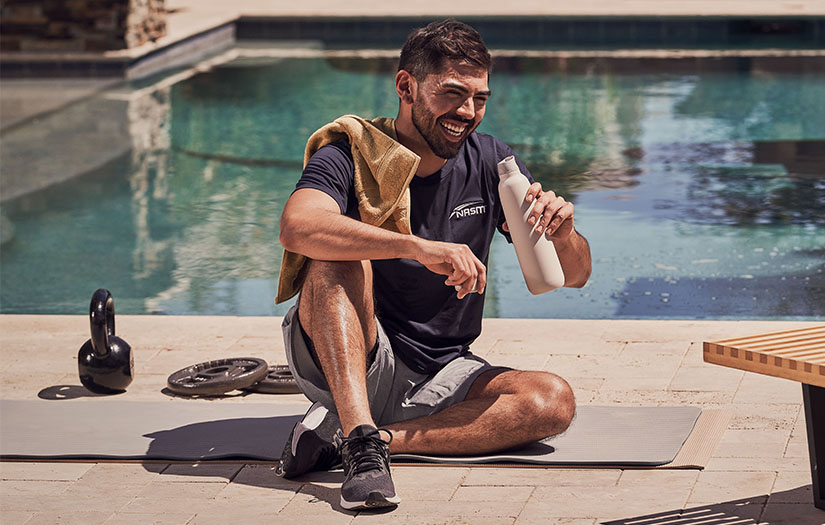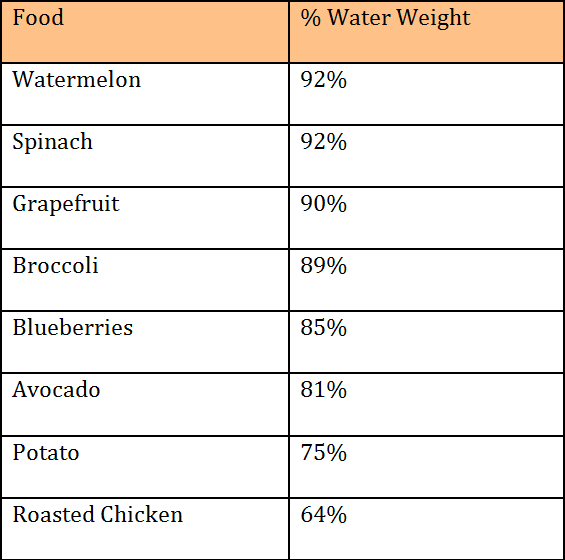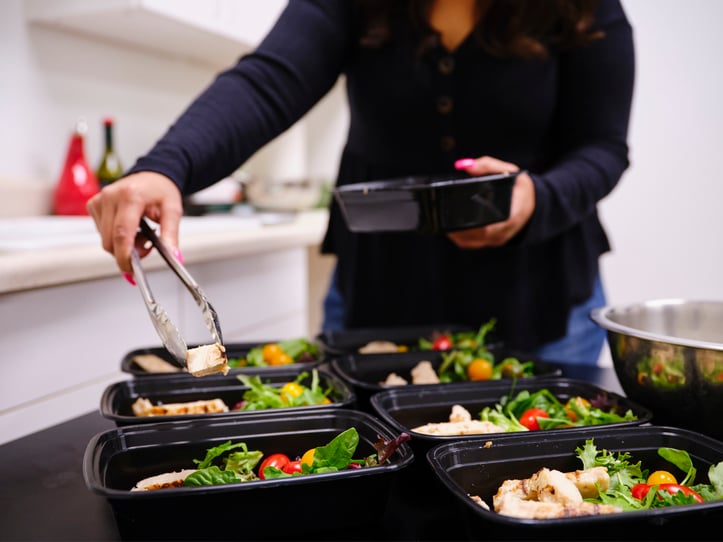Just how much water should you drink on a daily basis? Does the food you eat count toward this amount? Do you need as much water when exercising in the cold as you would in the heat? Will drinking water speed weight loss? Does dehydration affect athletic performance? If you’ve ever had questions like these about hydration, read on to find out why it is so important to keep properly hydrated.
We’ve all heard the advice to drink eight glasses of water a day. We’ve probably even told our clients to follow this standardized and unproven advice. But how much we actually need to drink is very individualized and depends on many factors, including gender, age, health issues, environment, and of course, activity levels.(1,2).
Generally, the recommended fluid intake for men is 125-130 oz/day (approx. 16 cups) and 91-95 oz/day (approx. 12 cups) for women (1,2). Fluids from all food and beverage sources count towards these amounts. Typically about 20% will come from foods (especially fruits and vegetables) and the other 80% from beverages (including caffeinated beverages) (1,2).
Learn more about hydration by checking out this guide to hydration.
Why is it so important to get enough fluids?
The human body is approximately 60% water (1). We can only survive a few days without water. The fluid levels in our body are constantly fluctuating as we lose or gain water. Water is key to our biological functions, including maintaining our core temperature, transporting nutrients to our cells, removing waste products and keeping our pH levels balanced (1-3).
Water is lost through:
- Sweating
- Urination/excretion
- Insensible water loss-continuous evaporation from the skin and lungs (e.g., perspiration and respiration)
Water is gained through:
- Food
- Beverages
- Metabolic processes (oxidation of protein, carbohydrates, and fat)
Monitoring Fluids the Easy Way
A simple way to monitor fluid status is to evaluate the color of urine throughout the day. If it is a pale yellow it likely indicates a well-hydrated state. If it is dark in color it probably indicates more fluids are needed. Another method is to weigh-in before and after a workout, replacing the weight difference with fluids. Thirst, obviously, is another indicator that the body needs fluids.
Peak Performance Sidelined by Dehydration
A dehydrated athlete probably won’t perform at peak levels. Dehydration tolerance is just as individualized as hydration needs (1). Performance wise, dehydration can decrease strength by 2%, power by 3%, and high-intensity endurance by about 10% (1).
Some of the reasons dehydration affects performance, especially for endurance activities combined with heat, include reduced plasma blood volume (leading to reduced stroke volume, increased heart rate), a decrease in blood flow to the skin (reducing the sweating response and heat dissipation), and an increase in core temperature (4,5).
Dehydration also has cognitive consequences, negatively affecting response time, coordination, tracking, short-term memory, attention, and mental focus (1). Feelings of fatigue take over faster and more recent research has even shown that dehydration increased brain activity related to painful stimuli (6).
So how much should an athlete consume to keep hydrated? The following chart lists recommendations from the American Dietetic Association, Dietitians of Canada, and the American College of Sports Medicine’s Fluid Replacement Guidelines (1):
If exercising less than an hour, water will generally meet hydration needs. For longer duration exercise, especially in the heat, a sports beverage will help replace the fluids and electrolytes lost.
Exercising in the Heat or Cold
As most of us have experienced, exercising in the heat increases sweat production. Evaporation of sweat is the body’s key mechanism for staying cool in hot environments. Maintaining ideal hydration levels typically requires an increase in fluid consumption, and potentially the addition of sodium and potassium to replace electrolytes lost in the sweat (1-3). (For more on exercising in the heat, click the link.)
But what about the cold? We tend to not think about dehydration as a factor in colder environments. Though our bodies are trying to conserve heat, sweating still occurs, especially with insulated layers of clothing. Colder environments have been shown to blunt the thirst sensation (7). Being in the cold can also increase urine output (diuresis) as fluids are pulled from the extremities toward the core (vasoconstriction) to maintain warmth, in addition to increased respiratory loss of fluids to dry air and/or altitude (8).
Water for Weight Loss
Can water help as an intervention to weight loss? It can definitely help to reduce overall calorie consumption if it replaces high calorie beverages. It can also help by adding feelings of fullness, aiding in digestion, slightly increasing metabolism, or avenge feelings of thirst that can often be mistaken for hunger (9). More recently, a study aimed to discover if a pre-meal glass of water would be a successful intervention as part of a weight loss diet.
The researchers found that the participants on a calorie restricted diet who drank +500 ml water before each meal lost more weight than those on the calorie restricted diet alone (10).
Too Much of a Good Thing: Hyponatremia
Hyponatremia, or water intoxication, is a dangerous condition that occurs when there is an excess of fluids consumed (exceeding the kidneys ability to quickly excrete) and an excessive loss or dilution of sodium (1-3). Endurance athletes (e.g., long distance runners, triathletes, cyclists) can be at risk for hyponatremia, especially if they are not replacing sodium lost in sweat and over hydrating during an event (1,2). Women and children are also more susceptible to hyponatremia due to their lower sweat rates and lower total body water (1,2). Unfortunately, hyponatremia has had fatal results not only during endurance events, but hazing incidences and other types of non-exercise contests as well (3).
References:
- Clark MA, Lucett SC. (2010). NASM’s Essentials of Sports Performance Training. Baltimore, MD: Lippincott Williams & Wilkins.
- National Research Council. (2005). Dietary Reference Intakes for Water, Potassium, Sodium, Chloride, and Sulfate. Washington, DC: The National Academies Press.
- Insel PM, Ross D, McMahon K, et al. (2011). Nutrition (4th edition). Sudbury, MA: Jones and Bartlett.
- Jeukendrup A, Gleeson M. (2010). Sport Nutrition: An Introduction to Energy Production and Performance (2nd Edition). Champaign, IL: Human Kinetics.
- Gonzalez-Alonso J, Mora-Rodriguez R, Below PR, Coyle EF. (1997). Dehydration markedly impairs cardiovascular function in hyperthermic endurance athletes during exercise. Journal of Applied Physiology, 82(4), 1229-1236.
- Ogino Y, Kakeda T, Nakamura K, Saito S. (2013). Dehydration enhances pain-evoked activation in the human brain compared with rehydration. Anesthesia and Analgesia. Advanced online publication. doi:10.1213/ANE.0b013e3182a9b028.
- Kenefick RW, Hazzard MP, Mahood NV, Castellani JW. (2004). Thirst sensations and AVP responses at rest and during exercise-cold exposure. Medicine and Science in Sports and Exercise, 36, 1528-1534.
- O’Brien C. (2003, December). Hydration in cold environments. RTO HFM Specialists’ Meeting on “Maintaining Hydration: Issues, Guidelines, and Delivery.” The RTO Human Factors and Medicine Panel (HFM) Specialists’ Meeting. NATO Science and Technology Organization, Boston, MA. RTO-MP-HFM-086, 9.1-9.8.
- Dennis EA, Dengo AL, Comber DL, Flack KD, Savla J, Davy KP, Davy BM. (2010). Water consumption increases weight loss during a hypocaloric diet intervention in middle-aged and older adults. Obesity, 18(2), 300-7.
- Boschmann, M. (2003) Water-induced thermogenesis. Journal of Clinical Endocrinology and Metabolism, 12(88), 6015-6019.


















